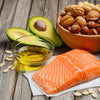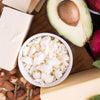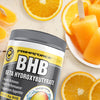Guide to a Successful Vegetarian Keto Diet

No meat? No problem. Because the keto diet is mainly made up of fats, you can be more creative about how you hit your protein macros. A successful vegetarian keto diet can be incredibly easy, depending on your flexibility.
While there are nutritional benefits associated with eating red meats and poultry in moderation, you can certainly still live a ketogenic lifestyle without them. In fact, looking at the bigger picture, the keto diet and vegetarian diet are more sustainable ways of dieting because they rely less on eating massive quantities of meat. Here’s what you can do:
1. Eggs (Ovo-Vegetarian)

If you’re a vegetarian who eats eggs or egg whites (ovo-vegetarian), incorporating a carton of eggs or egg whites into your diet is a perfect way to make sure you have enough protein in your diet. Eggs are also loaded with fat-soluble vitamins, iron, b-vitamins, and high-quality fat.
Something like this green omelette is a perfect breakfast for a vegetarian keto diet!
2. Pile on Cheese

A little cheese can go a long way. Freshly sliced mozzarella is packed with protein and fat, making it a perfect accessory for a vegetarian keto diet. Simply top vegetables like portobello mushrooms, eggplant rounds, or zucchini noodles with mozzarella and/or grated Parmesan for an instant protein boost.
This portobello mushroom pizza is shown topped with pepperoni, but you can omit that from the recipe to to make it vegetarian-friendly.
3. Meal Replacement Shake

A PrimaForce KetoShake is filling and contains the right macro ratios. Just mix with water or almond milk, add it to your morning coffee, or blend it into a smoothie and you’re good to go!
4. Seafood (Pescatarian)

If you’re flexible enough to allow fish or seafood in your diet, try our Parmesan-encrusted halibut. Packed with omega-3 fatty acids and protein, a little bit of seafood can go a long way.
5. High-Protein Veggies
Can’t include seafood or eggs in your diet? Try stocking up on these high-protein veggies. Just keep in mind you’ll probably need quite a lot to help reach your macros:
- Kale
- Peas (don’t overdo these, they’re starchy)
- Broccoli
- Sprouts
- Mushrooms
- Eggplant
- Squash
6. Other High-Protein Foods
While these additional options are high in protein, they also contain carbs. You’ll want to check the nutrition info per serving and make sure you can make it work in your meal plan. Options include:
- Nuts: macadamia, almonds, walnuts, pistachios
- Lentils: 2.5:1 carb to protein ratio per tablespoon
- Legumes: roughly 10 grams of carbs and 4-5 grams of protein per 1/2 cup




